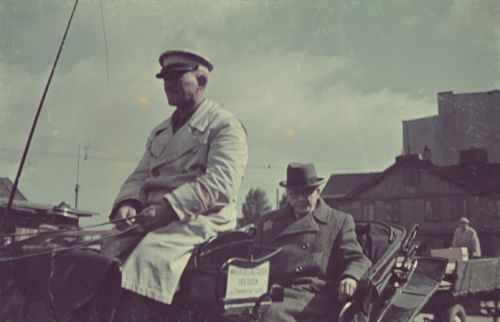Mordechai Chaim Rumkowski

Lodz Ghetto - Mordechai Chaim Rumkowski with driver- (USHMM)
Mordechai Chaim Rumkowski was born on March 27, 1877, in the village of Illino, Byelorussia. He received only a minimal formal education. He was a partner in a large velvet factory in Lodz before the First World War, but this venture was a failure, as was a subsequent business venture. However, he found that communal work, particularly in the field of child welfare, more successfully channeled his great energy and boundless ambition.
He organised the well-known orphanage in Helenowek, near Lodz and served as its Director until 1939. From 1931, onwards, he served on the Lodz kehillah, the Jewish Community Council, leading its Zionist faction. After the German occupation of Lodz, in 1939, the kehillah was replaced by a Council of Elders, and Rumkowski was appointed its chairman, the Eldest of the Jews, on October 13, 1939. With the establishment of the Lodz Ghetto, he became its virtual ruler. Rumkowski was torn between helping the Jewish population in the ghetto survive, and giving in to the demands of the German authorities. Rumkowski, however, is considered to be one of the most controversial of all Judenrat leaders, in that he often cooperated with the Germans and treated the Jews in the Litzmannstadt ghetto with a dictator-like manner.
Rumkowski reported directly to the German ghetto administration, which was headed by Hans Biebow, and Rumkowski was completely responsible for everyday life in the ghetto: providing food, housing, heat, work, and health and welfare services for those incarcerated in the ghetto. Rumkowski controlled all aspects of the ghetto, including its cultural life. When rabbis were forced to stop working , Rumkowski himself began performing marriages.
Rumkowski's picture even appeared on the ghetto's currency, the so-called 'Chaimki.' He was also responsible for establishing 120 factories, which employed thousands of the Jews in the ghetto, all employed in producing goods for the Germans. Rumkowski believed that if he could create a productive and vital work force for the Nazis, then they would not destroy the ghetto.
Rumkowski also believed that in order to save the ghetto as a whole, he would have to cooperate with the Nazis and agree to their deportation demands. By December 1941, the death camp at Chelmno had become operational and the German authorities forced Rumkowski to organise the deportation of a portion of the ghetto's population. Initially, Rumkowski tried to convince the Germans to reduce the number of Jews to be deported. However, the Germans refused and made Rumkowski responsible for deciding who was to be deported. During the first five months of 1942, some 59, 290 Jews and Gypsies from Lodz were sent to their deaths in the gas-vans at Chelmno.
During the early days of September 1942, another mass deportation was carried out. The Nazis demanded that Rumkowski turn over all the children and elderly in the ghetto. He agreed to these demands and calmly asked families to surrender their children with his infamous 'Give Me Your Children' speech on September 4, 1942. 15, 686 Jewish children, old people and others were brutally rounded-up and sent to their deaths in Chelmno.
After this appalling event, there was a respite from further deportations, which strengthened Rumkowski in his belief that keeping the peace and working for the Germans, would prevent further deportations. During this period of time, the Litzmannstadt Ghetto was left alone, while other ghetto's all over Poland were being destroyed.
However, by the early summer of 1944, with the Soviet Red Army advancing towards Litzmannstadt, the Nazis decided to liquidate the ghetto. Rumkowski and the Judenrat were forced to arrange another deportation 'aktion' and from June 23, 1944, until July 14, 1944, 7,186 Jews were sent to the re-established death camp at Chelmno, under the command of Hans Bothmann.
The Jewish population offered no resistance which led the Nazis to decide to completely liquidate the ghetto, and the SS and German Police units carrying out the mass deportations, during August 9 - August 29, 1944. Between 65,000- 67,000 Jews were deported to Auschwitz -Birkenau. Rumkowski and his family were not spared and they were sent to Auschwitz on August 28, and they were all murdered. Accounts of exactly how Rumkowski met his death are conflicting; some say he was murdered by Jews from Lodz, who were part of the Sonderkommando, whilst others claim he was murdered in the gas chambers.
Sources
Alan Adelson, Robert Lapides, Lodz Ghetto, Viking, New York, 1989
Chris Webb and Artur Hojan, Chelmno Death Camp, ibidem-verlag, Stuttgart, 2019
The Lodz Ghetto, Vademecum, Archiwum Panstwowe w Lodzi, Bilbo Lodz, 1999
The Warsaw Diary of Adam Czerniakow, Elephant Paperbacks, Ivan R. Dee, Chicago, 1999
Yad Vashem.org
Photograph: USHMM
© Holocaust Historical Society April 13, 2020

